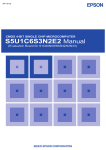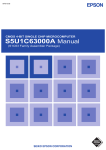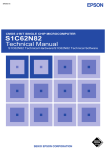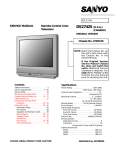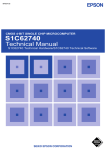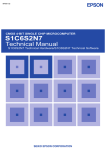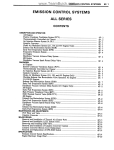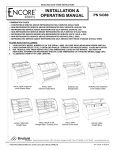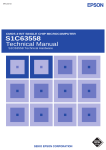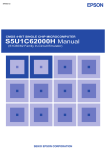Download Epson S5U1C62000A Product specifications
Transcript
MF1476-01 CMOS 4-BIT SINGLE CHIP MICROCOMPUTER S5U1C60N15E Manual (Evaluation Board for S1C60N15) NOTICE No part of this material may be reproduced or duplicated in any form or by any means without the written permission of Seiko Epson. Seiko Epson reserves the right to make changes to this material without notice. Seiko Epson does not assume any liability of any kind arising out of any inaccuracies contained in this material or due to its application or use in any product or circuit and, further, there is no representation that this material is applicable to products requiring high level reliability, such as medical products. Moreover, no license to any intellectual property rights is granted by implication or otherwise, and there is no representation or warranty that anything made in accordance with this material will be free from any patent or copyright infringement of a third party. This material or portions thereof may contain technology or the subject relating to strategic products under the control of the Foreign Exchange and Foreign Trade Law of Japan and may require an export license from the Ministry of International Trade and Industry or other approval from another government agency. © SEIKO EPSON CORPORATION 2001, All rights reserved. New configuration of product number Starting April 1, 2001, the product number has been changed as listed below. Please use the new product number when you place an order. For further information, please contact Epson sales representative. Devices S1 C 60N01 F 0A01 00 Packing specification Specification Package (D: die form; F: QFP) Model number Model name (C: microcomputer, digital products) Product classification (S1: semiconductor) Development tools C 60R08 S5U1 D1 1 00 Packing specification Version (1: Version 1) Tool type (D1: Development Tool) Corresponding model number (60R08: for S1C60R08) Tool classification (C: microcomputer use) Product classification (S5U1: development tool for semiconductor products) CONTENTS S5U1C60N15E Manual (Evaluation Board for S1C60N15) This manual describes how to operate the S5U1C60N15E, a debugging tool for the S1C60N15 4-bit, singlechip microcomputer. Refer to the "S1C60N15 Technical Manual" for details of the S1C60N15, and the "S5U1C62000A Manual" and the "S1C60/62 Family Development Tool Manual" for the development procedure and other information. Contents 1 INTRODUCTION ______________________________________________ 1 1.1 1.2 S5U1C60N15E Outline ............................................................................................ 1 S5U1C60N15E Components .................................................................................... 1 2 PRODUCT SPECIFICATIONS ___________________________________ 2 3 NAMES AND FUNCTIONS OF PARTS ____________________________ 3 3.1 3.2 Basic Functions ........................................................................................................ 3 Functions of Parts .................................................................................................... 3 3.2.1 Front panel ..................................................................................................... 3 3.2.2 Rear panel ....................................................................................................... 3 3.2.3 Board (under top cover) ................................................................................. 4 3.3 S5U1C60N15E I/O, LCD and Sub-board Connectors ............................................. 6 4 CABLE CONNECTION _________________________________________ 7 4.1 4.2 4.3 Connection to ICE .................................................................................................... 7 Power Cable Connection .......................................................................................... 8 Connection to Target System .................................................................................... 8 5 OPERATION METHOD OF S5U1C60N15E ________________________ 9 5.1 Preparation .............................................................................................................. 9 5.1.1 Creation of target system ................................................................................ 9 5.1.2 Creation and installation of ROMs ................................................................ 9 5.2 Independent Use of S5U1C60N15E ........................................................................ 10 5.2.1 Power on/off .................................................................................................. 10 5.2.2 Debugging ..................................................................................................... 10 5.3 Operation When ICE is Connected ......................................................................... 10 5.3.1 Power on/off .................................................................................................. 10 5.3.2 Debugging ..................................................................................................... 10 6 PRECAUTIONS ________________________________________________ 11 6.1 6.2 Precautions for Operation ....................................................................................... 11 Differences from Actual IC ...................................................................................... 11 S5U1C60N15E MANUAL (EVALUATION BOARD FOR S1C60N15) EPSON i 1 INTRODUCTION 1 INTRODUCTION 1.1 S5U1C60N15E Outline The S5U1C60N15E is a development tool for the S1C60N15. Almost the same functions that the S1C60N15 CPU has can be implemented by writing application program and option data created by the option generator into EPROM, and installing it in the S5U1C60N15E. S5U1 S1C6 0N15 C60N EVAL 15E1 UATI ON BO AR D In addition, the S5U1C60N15E can interface with the in-circuit emulator ICE (S5U1C62000H), and so perform a higher level of debugging. 1.2 S5U1C60N15E Components When unpacking the S5U1C60N15E, check that the following goods are present: (1) (2) (3) (4) (5) (6) (7) (8) (9) S5U1C60N15E main unit ...................................................................................... 1 LCD connection cable and connector (60-pin flat type) .................................. 1 set I/O connection cable and connector (50-pin flat type) ................................... 2 set Power cable (3-pin) ................................................................................................ 1 set Fuse (3 A) ................................................................................................................. 1 S5U1C60N15E Manual (Evaluation Board for S1C60N15) (this manual) .... 1 Warranty registration card ................................................................................... 1 Warranty certificate ............................................................................................... 1 Notes on use ........................................................................................................... 1 Manual Warranty certificate Warranty registration card Notes on use I/O I/O #1 #0 LC LC D D #0 #1 S5U1C60N15E1 S1C60N15 EVALUATION BOARD EPSON LCD EMU. I/O connection cable and connector (2 set) LCD connection cable and connector Power cable Fuse Fig. 1.2.1 S5U1C60N15E package S5U1C60N15E MANUAL (EVALUATION BOARD FOR S1C60N15) EPSON 1 2 PRODUCT SPECIFICATIONS 2 PRODUCT SPECIFICATIONS The components specifications of the S5U1C60N15E are listed below. ■ S5U1C60N15E Dimensions: Weight: Color: Power supply: Board: Operating conditions: 203 mm (width) × 275 mm (depth) × 65 mm (height) (Including rubber feet) About 2.04 kg (main unit only) Cygnus white 5 V (±10%) DC, 3 A or more (from external power supply) When connected to the ICE, power is supplied by the ICE. Main board × 1 Sub board × 1 Operating temperature 5°C to 40°C Storage temperature -20°C to 60°C Operating humidity 35% to 80% Storage humidity 20% to 90% Resistance to vibration Operating 0.25G max. Transportation 2G max. Resistance to impulse Operating 1G max. Standby 2G max. ■ LCD connection cable S5U1C60N15E connector: Cable connector: Cable: Interface: Length: J3372-P302VE or equivalent 7960-6500SC 60-pin flat cable × 1 CMOS interface (5 V) About 50 cm ■ I/O cable S5U1C60N15E connector: Cable connector: Cable: Interface: Length: J3433-P302VE or equivalent 7950-6500SC 50-pin flat cable × 2 CMOS interface (5 V) About 50 cm (Two cables are same) ■ Power cable S5U1C60N15E connector: Cable connector: Other side connector: Cable length: Capacity: 2 MOLEX 5276-03A or equivalent MOLEX 5196-03 (According to power supply specifications) About 80 cm 5 V DC, 3 A or more EPSON S5U1C60N15E MANUAL (EVALUATION BOARD FOR S1C60N15) 3 NAMES AND FUNCTIONS OF PARTS 3 NAMES AND FUNCTIONS OF PARTS This section describes the names and functions of the parts of the S5U1C60N15E. 3.1 Basic Functions The S5U1C60N15E has the following basic functions: ■ Program execution (Run function) Install the EPROM containing the application program and execute the program. ■ Interface with ICE The S5U1C60N15E can interface with the ICE so that a higher level debugging environment may be established. ■ Setting hardware options by installing function option and segment option ROMs Hardware options, i.e., I/O ports and segments, can be specified by writing option data for the function option created by the function option generator and the segment option created by the segment option generator into EPROM, and installing the EPROM. 3.2 Functions of Parts 3.2.1 Front panel I/O #1 •••••••••••••••••••••••••••• •••••••••••••••••••••••••••• ••••••••••••••••••••••••••••••••• ••••••••••••••••••••••••••••••••• LC •••••••••••••••••••••• •••••••••••••••••••••• D #0 LC D #1 EPSON •••••••••••••••••••••••••••• •••••••••••••••••••••••••••• I/O S1C60N15 EVALUATION BOARD #0 ■ Connectors S5U1C60N15E1 • I/O #0, I/O #1 Connector for the I/O cable. The I/O cable is used to connect the S5U1C60N15E to the target system. LCDEMU ▲ Position of pin 1 Fig. 3.2.1.1 Front panel • LCD #0, LCD #1 Connector for the LCD cable. The LCD cable is used to connect the S5U1C60N15E to the target system. LCD #1 cannot be used. • LCDEMU Connector for the LCD emulator cable. 3.2.2 Rear panel ■ Switch +5V GND O I DC IN •••••••••••••••••••••••••••• •••••••••••••••••••••••••••• F1 •••••••••••••••••••••••••••• •••••••••••••••••••••••••••• F5 POWER SW ▲ Position of pin 1 Fig. 3.2.2.1 Rear panel Note: Be sure to disconnect external power source before connection with ICE, because power is supplied from ICE when you connect S5U1C60N15E to ICE. • POWER SW This is a switch to turn on (I) or off (O) the external power supply to S5U1C60N15E. (Please turn off the POWER switch when ICE is connected.) ■ Connectors • DC IN 5 V This is a connector with external power supply source. The external power supply should be in direct current of 5 V for 3 A or more. • F1, F5 Connectors for the ICE interface cable. S5U1C60N15E MANUAL (EVALUATION BOARD FOR S1C60N15) EPSON 3 3 NAMES AND FUNCTIONS OF PARTS • • • • • • • • • • • • • • • • • • • • • • • • • • RESET DONE LED8 LED7 LED6 LED5 H.HEX Front F.HEX L.HEX 25 26 SVDT POWER VADJ HLT/SLP 1 2 LED1: OSCC LED2: CLKCHG LED3: SVDON LED4: HVLD LED5: LFHX LED6: LED7: LOF LED8: SWRUN LED9: DONE LCA ROM AD0 SHEXLD S.HEX FUSE1 SUB BOARD CONNECTOR OSC3CR OSC1CR 3.2.3 Board (under top cover) LED4 LED3 LED2 LED1 LED9 Fig. 3.2.3.1 Layout on the board ■ ROM sockets • L.HEX, H.HEX These are IC sockets for target program ROMs. Insert the ROM (L.HEX) containing the 8 low-order bits (I7 to I0) of the machine code into the L.HEX socket, and the ROM (H.HEX) containing the 4 highorder bits (IB to I8) into the H.HEX socket. • F.HEX This is the IC socket into which the ROM (F.HEX) is inserted. This ROM includes the function options generated by the function option generator (winfog). • S.HEX This is the IC socket into which the ROM (S.HEX) is inserted. This ROM includes the segment options generated by the segment option generator (winsog). • LCA ROM This is the S1C60N15 peripheral circuit ROM. ■ Switch • RESET switch This switch resets the CPU and starts the target program from page 01H, step 00H. ■ FUSE • FUSE1 This is 3 A tubular fuse for external power supply, and is blown off by current of 3 A or more. ■ Controls • OSC3CR This is the control for varying the OSC3 CR oscillation frequency. This control is effective only when CR oscillation is selected for the OSC3 oscillator type by mask option. The CR oscillation frequency can be checked with an oscilloscope or other instrument by connecting to pin 10 of the sub-board connector. Turning clockwise: High frequency Turning counterclockwise: Low frequency 4 EPSON S5U1C60N15E MANUAL (EVALUATION BOARD FOR S1C60N15) 3 NAMES AND FUNCTIONS OF PARTS • VADJ This is the control for adjusting the LCD contrast. (Refer to Section 6.2, "Differences from Actual IC".) • SVDT This is the control for varying the power supply voltage in simulation to check SVD operation. (Refer to Section 6.2, "Differences from Actual IC".) Turning clockwise: Level low Turning counterclockwise: Normal ■ LEDs • POWER This LED lights when the S5U1C60N15E goes on. • HLT/SLP This LED lights when the CPU enters HALT status. • AD0 This LED indicates the status of the address 0 (AD0) signal. It can be used to check whether or not the S5U1C60N15E works. • SHEXLD This LED lights when segment option data from a personal computer is loaded using the in-circuit emulator ICE. As the result, it can differentiate whether the currently specified segment option is due to the ROM (S.HEX) or has been loaded from a personal computer. Refer to the "S5U1C62000A Manual" in regard to the loading of the segment option using the ICE. • LED1 (OSCC) This LED lights when the OSCC register (address 2FEH•D1) is set to "1" and goes off when the register is set to "0". • LED2 (CLKCHG) This LED lights when the CLKCHG register (address 2FEH•D2) is set to "1" and goes off when the register is set to "0". • LED3 (SVDON) This LED lights when the SVDON register (address 2FFH•D3) is set to "1" and goes off when the register is set to "0". • LED4 (HVLD) This LED lights when the HLMOD register (address 2E6H•D3) is set to "1" and goes off when the register is set to "0". • LED5 (LFHX) This LED lights when function option data from a personal computer is loaded using the in-circuit emulator ICE. As the result, it can differentiate whether the currently specified function option is due to the ROM (F.HEX) or has been loaded from a personal computer. Refer to the "S5U1C62000A Manual" in regard to the loading of the function option using the ICE. • LED7 (LOF) This LED lights when the LOF register (address 2D0H•D0) is set to "0" and goes off when the register is set to "1". • LED8 (SWRUN) This LED lights when the SWRUN register (address 2EEH•D2) is set to "1" and goes off when the register is set to "0". • LED9 (DONE) This LED lights when the S5U1C60N15E has completed configuration at power-on and is ready for debugging. If this LED does not light several seconds after poweron, turn the power off and then on again. ■ Test pins The status of the following signals can be checked by an oscilloscope or other instrument. • SUB BOARD CONNECTOR Pin 10 (OSC3CR) This pin is used to monitor the OSC3 CR oscillation clock. • SUB BOARD CONNECTOR Pin 11 (OSC3CE) This pin is used to monitor the OSC3 ceramic oscillation clock. S5U1C60N15E MANUAL (EVALUATION BOARD FOR S1C60N15) EPSON 5 3 NAMES AND FUNCTIONS OF PARTS 3.3 S5U1C60N15E I/O, LCD and Sub-board Connectors Table 3.3.1 I/O #0 connector pins Pin No. 1 3 5 7 9 11 13 15 17 19 21 23 25 27 29 31 33 35 37 39 41 43 45 47 49 Signal name VDD (+5 V) Cannot be connected Cannot be connected R00 R02 R10 R12 Cannot be connected Cannot be connected K00 K02 K10 Cannot be connected K20 K22 P00 P02 P10 P12 Cannot be connected Cannot be connected Cannot be connected Cannot be connected Cannot be connected VSS (GND) Pin No. 2 4 6 8 10 12 14 16 18 20 22 24 26 28 30 32 34 36 38 40 42 44 46 48 50 Table 3.3.2 I/O #1 connector pins Signal name Pin No. VDD (+5 V) Cannot be connected Cannot be connected R01 R03 R11 R13 Cannot be connected Cannot be connected K01 K03 Cannot be connected Cannot be connected K21 K23 P01 P03 P11 P13 Cannot be connected Cannot be connected RESET Cannot be connected Cannot be connected VSS (GND) 1 3 5 7 9 11 13 15 17 19 21 23 25 27 29 31 33 35 37 39 41 43 45 47 49 Table 3.3.3 LCD #0 connector pins Pin No. 1 3 5 7 9 11 13 15 17 19 21 23 25 27 29 31 33 35 37 39 41 43 45 47 49 51 53 55 57 59 6 Signal name COM0 COM2 Cannot be connected Cannot be connected SEG0 SEG2 SEG4 SEG6 SEG8 SEG10 SEG12 SEG14 SEG16 SEG18 SEG20 SEG22 SEG24 SEG26 SEG28 SEG30 SEG32 SEG34 SEG36 SEG38 SEG40 SEG42 SEG44 SEG46 Cannot be connected Cannot be connected Pin No. 2 4 6 8 10 12 14 16 18 20 22 24 26 28 30 32 34 36 38 40 42 44 46 48 50 52 54 56 58 60 Signal name VDD (+5 V) Cannot be connected VDD (+5 V) Cannot be connected V1 V3 V5 N.C. Cannot be connected N.C. Cannot be connected N.C. Cannot be connected Cannot be connected Cannot be connected Cannot be connected N.C. Cannot be connected Cannot be connected Cannot be connected N.C. N.C. N.C. N.C. VSS (GND) Pin No. 2 4 6 8 10 12 14 16 18 20 22 24 26 28 30 32 34 36 38 40 42 44 46 48 50 Signal name VDD (+5 V) Cannot be connected VDD (+5 V) Cannot be connected V2 V4 N.C. N.C. Cannot be connected N.C. Cannot be connected N.C. Cannot be connected Cannot be connected Cannot be connected Cannot be connected N.C. Cannot be connected Cannot be connected Cannot be connected N.C. N.C. N.C. N.C. VSS (GND) Table 3.3.4 Sub-board connector pins Pin No. Signal name COM1 COM3 Cannot be connected Cannot be connected SEG1 SEG3 SEG5 SEG7 SEG9 SEG11 SEG13 SEG15 SEG17 SEG19 SEG21 SEG23 SEG25 SEG27 SEG29 SEG31 SEG33 SEG35 SEG37 SEG39 SEG41 SEG43 SEG45 SEG47 Cannot be connected Cannot be connected 1 3 5 7 9 11 13 15 17 19 21 23 25 EPSON Signal name VDD (+5 V) Cannot be connected Cannot be connected Cannot be connected Cannot be connected OSC3CE Cannot be connected Cannot be connected Cannot be connected Cannot be connected Cannot be connected Cannot be connected Cannot be connected Pin No. 2 4 6 8 10 12 14 16 18 20 22 24 26 Signal name Cannot be connected Cannot be connected Cannot be connected Cannot be connected OSC3CR Cannot be connected Cannot be connected Cannot be connected Cannot be connected Cannot be connected Cannot be connected Cannot be connected VSS (GND) S5U1C60N15E MANUAL (EVALUATION BOARD FOR S1C60N15) 4 CABLE CONNECTION 4 CABLE CONNECTION This section describes how to connect the power cable to the S5U1C60N15E, and the S5U1C60N15E to the ICE and the target system. Note: Turn the power of all equipment off before connecting or disconnecting cables. 4.1 Connection to ICE The S5U1C60N15E is connected to the ICE by connecting the two interface cables (F1 and F5). Use S5U1C60N15E connectors F1 and F5 with the projections facing outwards. Use ICE connectors F1 and F5 with the projections facing inwards (cable side). Figures 4.1.1 and 4.1.2 show the external view and connection diagram of the ICE interface cable. 2 1 : : : : : : : : : : 50 49 S5U1C60N15E side 2 1 : : : : : : : : : : 50 49 ICE side Fig. 4.1.1 External view of the ICE interface cable ICE S5U1C60N15E Red mark ←F1 connector ←F5 connector F1 connector→ F5 connector→ Fig. 4.1.2 Connection diagram Note: The S5U1C60N15E has an external power input connector for +5 V (VDD) and GND (VSS). Leave these connectors unconnected when the S5U1C60N15E is connected to the ICE. S5U1C60N15E MANUAL (EVALUATION BOARD FOR S1C60N15) EPSON 7 4 CABLE CONNECTION 4.2 Power Cable Connection When using the S5U1C60N15E on its own, it must be supplied with power (5 V DC, 3 A or more) from an external source through the power cable. When the S5U1C60N15E is connected to the ICE, power is supplied by the ICE; therefore, the power cable is not necessary. Disconnect the power cable if it is already connected. Figure 4.2.1 shows the connection of the power cable pins. Black - Connect to the external power supply + Connect to the power connector of the S5U1C60N15E Red Fig. 4.2.1 Connection of power cable pins 4.3 Connection to Target System The I/O #0, I/O #1 and LCD #0 connectors are used to connect the S5U1C60N15E to the target system. S5U1C60N15E I/O #0 I/O I/O cable connectors I/O #1 Target system LCD LCD #0 connector LCD cable Front Fig. 4.3.1 Connection of target system The signals output from the LCD #0 connector are the same as those of the actual IC at the function level. Therefore, the S5U1C60N15E may be connected to the LCD of the target system without any changes. 8 EPSON S5U1C60N15E MANUAL (EVALUATION BOARD FOR S1C60N15) 5 OPERATION METHOD OF S5U1C60N15E 5 OPERATION METHOD OF S5U1C60N15E 5.1 Preparation This section describes the common preparation work necessary when the S5U1C60N15E is used by itself and when it is connected to the ICE. Before doing the following, be sure to turn the POWER switch of the S5U1C60N15E off. 5.1.1 Creation of target system Mount the LCD panel, keys, and switches on the board to build a target system. Use the I/O connector and LCD connector supplied with the S5U1C60N15E to connect the S5U1C60N15E to the target system. (For the pin layout of each connector, refer to Section 3.3, "S5U1C60N15E I/O, LCD and Sub-board Connectors".) Note: There is some difference in specifications between the S5U1C60N15E and the actual CPU. Refer to Section 6.2, "Differences from Actual IC" when building a target system. 5.1.2 Creation and installation of ROMs Create the program ROMs, function option ROM and segment option ROM, and insert them into the sockets of the S5U1C60N15E. • Program ROMs (two) The program ROMs contain the application program machine code. Write the HEX files, that are converted into the Intel-HEX format by the HEX converter (hx62) from the object files generated by the linker (lk62), into EPROMs to create program ROMs. Refer to the "S5U1C62000A Manual" for lk62 and hx62. Since two HEX files containing the high-order section (zzzzzzzH.HEX) and the low-order section (zzzzzzzL.HEX) of the machine code are output, two ROMs are created. Insert them into the socket H.HEX and L.HEX under the top cover, respectively. Table 5.1.2.1 Offset address These ROMs are not necessary when connecting the EPROM type Offset value S5U1C60N15E to the ICE. In addition, it is necessary 27C64 0000H (without offset) to write the object data into the EPROM attaching 27C128 0000H (without offset) the offset address as Table 5.1.2.1 according to the 27C256 4000H type of EPROM that is used. 27C512 C000H • Function option ROM (one) The function option ROM is used to specify function options, such as I/O ports. Create the option ROM from the function option HEX file (zzzzzzzF.HEX) output by the function option generator, and insert it into the F.HEX socket under the top cover. This ROM is effective even when the ICE is connected, however, this ROM is disregarded due to the loading of the data from the ICE. • Segment option ROM (one) The segment option ROM is used to specify segment output port. Create the segment ROM from the segment option HEX file (zzzzzzzS.HEX) output by the segment option generator, and insert it into the S.HEX socket in the top cover. This ROM is effective even when the ICE is connected, however, this ROM is disregarded due to the loading of the data from the ICE. • EPROM specifications Use EPROMs with the following specifications: Program ROM: 27C64 to 27C512 Function option ROM: 27C64 to 27C512 Segment option ROM: 27C64 to 27C512 S5U1C60N15E MANUAL (EVALUATION BOARD FOR S1C60N15) (250 ns or less access time) (250 ns or less access time) (250 ns or less access time) EPSON 9 5 OPERATION METHOD OF S5U1C60N15E 5.2 Independent Use of S5U1C60N15E This section describes operation when using the S5U1C60N15E by itself. The S5U1C60N15E may be used independently by connecting a power supply to it. Use a 5 V DC regulator (more than 3 A) as an external power supply. Connect it with the correct polarity (+ and -). (Refer to Section 4.2, "Power Cable Connection".) 5.2.1 Power on/off Before turning the POWER switch of the S5U1C60N15E on, confirm the following: (1) The power cable is connected correctly. (2) The target system is connected correctly. (3) The ROMs have been installed correctly. After confirming the above items, turn the POWER switch of the S5U1C60N15E on using the following procedure: (1) Turn the regulator on. If the regulator is a variable-voltage type, set the output voltage to 5 V ±10%. (2) Turn the POWER switch of the S5U1C60N15E on. 5.2.2 Debugging When the S5U1C60N15E is used alone, it provides the following debugging function. The method of operation is given below. • Program free run When the RESET switch (under the top cover) is pressed, the S5U1C60N15E enters the program run state, and executes the application program from page 1, step 0. 5.3 Operation When ICE is Connected This section explains the operation and use of the S5U1C60N15E when it is connected to the ICE. Set up the S5U1C60N15E as follows when it is connected to the ICE: (1) Do not connect the power supply. (2) Keep on turning the POWER switch off. 5.3.1 Power on/off Power to the S5U1C60N15E is supplied by the ICE, and the power is switched on and off by pressing the POWER switch of the ICE. Keep the POWER switch of the S5U1C60N15E off. 5.3.2 Debugging Debugging is done with the host computer, and the S5U1C60N15E is controlled by the ICE. For the method of operation, refer to the "S5U1C62000A Manual". The S5U1C60N15E can control the following four functions: (1) (2) (3) (4) 10 RESET input OSC3 CR oscillation frequency adjustment with the OSC3CR control Pseudo power supply voltage change with the SVDT control LCD contrast adjustment with the VADJ control EPSON S5U1C60N15E MANUAL (EVALUATION BOARD FOR S1C60N15) 6 PRECAUTIONS 6 PRECAUTIONS Take the following precautions when using the S5U1C60N15E: 6.1 Precautions for Operation • Turn the power of all equipment off before connecting or disconnecting cables. • To turn the POWER switch of the S5U1C60N15E off, then on again, wait for at least 10 seconds after turning off before turning on. • When ROMs are inserted into the ROM sockets, lock the lever securely by positioning it horizontally. After the ROMs have been removed from the sockets, lock the lever at the same position above. If the lever is left upright, poor contact may result. • Confirm that the following ROMs have been installed correctly, then operate the S5U1C60N15E. (Top panel) Program ROM 2 L.HEX, H.HEX (Under top cover) Function option ROM 1 F.HEX (Under top cover) Segment option ROM 1 S.HEX 6.2 Differences from Actual IC There are some differences in functions between the S5U1C60N15E and the actual IC. ■ I/O • The response time has been changed by the differences in logic level, output drive capability, and pull-down resistance. The minimum operating voltage is also different from the actual IC. • The K ports and the P ports of the S5U1C60N15E have a 100 kΩ pull-down resistor which are different from those of the actual IC. • When the segment terminals are set to DC output, the output signals are delivered with 0 V and +5 V. ■ LCD • The LCD contrast is adjusted by the VADJ control. However, the contrast level of each actual IC is fixed, so it cannot be adjusted. • The output drive capability is different. • If the internal voltage regulator is disabled by mask option, short-circuit the LCD power supply terminals and supply external voltage as shown in Table 6.2.1. Table 6.2.1 LCD drive voltage supplied externally 1/2 bias Pins to be Voltage to be short-circuited supplied V0–V3 VC2 (Typ. 3.0 V) V1–V4 VC1 (Typ. 1.5 V) V2–V5 VSS (0 V) — — 1/3 bias Pins to be Voltage to be short-circuited supplied V0 VC3 (Typ. 3.0 V) V1–V3 VC2 (Typ. 2.0 V) V2–V4 VC1 (Typ. 1.0 V) V5 VSS (0 V) ■ Power-on sequence differences The S5U1C60N15E performs configuration and determines the internal state when the power is turned on. Then, it works as the actual IC does. Therefore, the I/O state of the S5U1C60N15E is unstable until configuration is completed. This affects the power-on reset time. ■ Difference in current consumption It is impossible to evaluate current consumption using the S5U1C60N15E. S5U1C60N15E MANUAL (EVALUATION BOARD FOR S1C60N15) EPSON 11 6 PRECAUTIONS ■ Function differences <SVD circuit> • The SVD function is implemented by varying the apparent power supply voltage with the SVDT control. • The SVD response time is different from the actual IC. It is necessary to take an appropriate waiting time for getting the SVD result. <Oscillation circuit> • For OSC1, 32.768 kHz or 38.4 kHz crystal oscillation can be selected. The OSC3 oscillation frequency is fixed at 1 MHz when ceramic oscillation is used. When CR oscillation is used, the frequency can be adjusted approximately from 50 kHz to 1400 kHz using the OSC3CR control mounted on the board. Either OSC1 or OSC3 can be selected as the system clock. • The oscillation stabilization time for OSC3 and OSC1 is shorter than the actual IC. The time from turning the OSC3 oscillation on to switching the system clock to OSC3 should be secured according to the time of the actual IC. • Use separate instructions for turning the OSC3 oscillation on and for switching the clock from OSC1 to OSC3. The same applies when turning the OSC1 oscillation off after switching the clock from OSC3 to OSC1. The S5U1C60N15E may operate if this processing is performed at the same time. Be sure to use separate instructions according to the actual IC when creating the program. • The oscillation start and stop times are different from those of the actual IC, because the logic level of the S5U1C60N15E is higher than that of the actual IC. <Undefined data memory area> In the S5U1C60N15E, values that are read from unmapped memory areas will be undefined. However, the undefined status differs from the actual IC, therefore pay attention to the memory area when creating programs. Refer to the "S1C60N15 Technical Manual" for the memory map. 12 EPSON S5U1C60N15E MANUAL (EVALUATION BOARD FOR S1C60N15) International Sales Operations AMERICA ASIA EPSON ELECTRONICS AMERICA, INC. EPSON (CHINA) CO., LTD. - HEADQUARTERS - 23F, Beijing Silver Tower 2# North RD DongSanHuan ChaoYang District, Beijing, CHINA Phone: 64106655 Fax: 64107319 150 River Oaks Parkway San Jose, CA 95134, U.S.A. Phone: +1-408-922-0200 Fax: +1-408-922-0238 SHANGHAI BRANCH 4F, Bldg., 27, No. 69, Gui Jing Road Caohejing, Shanghai, CHINA Phone: 21-6485-5552 Fax: 21-6485-0775 - SALES OFFICES West 1960 E. Grand Avenue EI Segundo, CA 90245, U.S.A. Phone: +1-310-955-5300 Fax: +1-310-955-5400 Central 101 Virginia Street, Suite 290 Crystal Lake, IL 60014, U.S.A. Phone: +1-815-455-7630 Fax: +1-815-455-7633 Northeast 301 Edgewater Place, Suite 120 Wakefield, MA 01880, U.S.A. Phone: +1-781-246-3600 Fax: +1-781-246-5443 EPSON HONG KONG LTD. 20/F., Harbour Centre, 25 Harbour Road Wanchai, Hong Kong Phone: +852-2585-4600 Fax: +852-2827-4346 Telex: 65542 EPSCO HX EPSON TAIWAN TECHNOLOGY & TRADING LTD. 10F, No. 287, Nanking East Road, Sec. 3 Taipei Phone: 02-2717-7360 Fax: 02-2712-9164 Telex: 24444 EPSONTB HSINCHU OFFICE Southeast 3010 Royal Blvd. South, Suite 170 Alpharetta, GA 30005, U.S.A. Phone: +1-877-EEA-0020 Fax: +1-770-777-2637 13F-3, No. 295, Kuang-Fu Road, Sec. 2 HsinChu 300 Phone: 03-573-9900 Fax: 03-573-9169 EPSON SINGAPORE PTE., LTD. No. 1 Temasek Avenue, #36-00 Millenia Tower, SINGAPORE 039192 Phone: +65-337-7911 Fax: +65-334-2716 EUROPE EPSON EUROPE ELECTRONICS GmbH SEIKO EPSON CORPORATION KOREA OFFICE - HEADQUARTERS Riesstrasse 15 80992 Munich, GERMANY Phone: +49-(0)89-14005-0 Fax: +49-(0)89-14005-110 SALES OFFICE Altstadtstrasse 176 51379 Leverkusen, GERMANY Phone: +49-(0)2171-5045-0 Fax: +49-(0)2171-5045-10 UK BRANCH OFFICE Unit 2.4, Doncastle House, Doncastle Road Bracknell, Berkshire RG12 8PE, ENGLAND Phone: +44-(0)1344-381700 Fax: +44-(0)1344-381701 50F, KLI 63 Bldg., 60 Yoido-dong Youngdeungpo-Ku, Seoul, 150-763, KOREA Phone: 02-784-6027 Fax: 02-767-3677 SEIKO EPSON CORPORATION ELECTRONIC DEVICES MARKETING DIVISION Electronic Device Marketing Department IC Marketing & Engineering Group 421-8, Hino, Hino-shi, Tokyo 191-8501, JAPAN Phone: +81-(0)42-587-5816 Fax: +81-(0)42-587-5624 ED International Marketing Department Europe & U.S.A. FRENCH BRANCH OFFICE 1 Avenue de l' Atlantique, LP 915 Les Conquerants Z.A. de Courtaboeuf 2, F-91976 Les Ulis Cedex, FRANCE Phone: +33-(0)1-64862350 Fax: +33-(0)1-64862355 BARCELONA BRANCH OFFICE Barcelona Design Center Edificio Testa, Avda. Alcalde Barrils num. 64-68 E-08190 Sant Cugat del Vallès, SPAIN Phone: +34-93-544-2490 Fax: +34-93-544-2491 421-8, Hino, Hino-shi, Tokyo 191-8501, JAPAN Phone: +81-(0)42-587-5812 Fax: +81-(0)42-587-5564 ED International Marketing Department Asia 421-8, Hino, Hino-shi, Tokyo 191-8501, JAPAN Phone: +81-(0)42-587-5814 Fax: +81-(0)42-587-5110 S5U1C60N15E Manual (Evaluation Board for S1C60N15) ELECTRONIC DEVICES MARKETING DIVISION EPSON Electronic Devices Website http://www.epson.co.jp/device/ Issue September, 2001 Printed in Japan L A




















